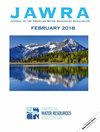未来气候条件下达诺流域3种与水相关的生态系统服务评价
IF 2.6
4区 环境科学与生态学
Q3 ENGINEERING, ENVIRONMENTAL
引用次数: 0
摘要
本研究评估了未来气候变化对达诺流域三种水相关生态系统服务(WRES)的影响。对HBV light概念降雨径流模型进行了校正(NSE = 0.945, R²= 0.945,KGE= 0.948)和验证(NSE = 0.648, R²= 0.798,KGE= 0.551),结果表明观测变量和模拟变量吻合良好。利用WASCAL高分辨率区域气候模拟(HadGEM2-ES和GFDL-ESM2M在RCP 4.5下)对参考期(1985-2005)和未来期(2020-2049和2070-2099)预估的流域气候变化信号进行了分析。与参考期相比,两种气候模式都显示,到2020-2049年,温度将升高+1.9至+2.8°C,到本世纪末,温度将升高3.2至5.4°C。预计本世纪中叶的降水趋势为+ 10%至+ 30%,到2100年的降水趋势为+ 37%至+51.4%。预估的年排放变化信号显示,到2049年将增加+ 25%至+ 68%,而到本世纪末,这一增幅将超过+ 80.65%。模拟的水文变化被转化为WRES供应(水电、生活用水和生态流量)的变化。预计排放量的增加将转化为水力发电潜力的增加,但这一排放量的增加将不足以满足未来额外的生活用水需求。由于人口增长,家庭用水供应将会减少。因此,预计未来排放量的增加将不足以抵消与人口发展有关的额外用水需求。本文章由计算机程序翻译,如有差异,请以英文原文为准。
An Assessment of Three Water Related Ecosystem Services in the Dano Catchment under Future Climate Conditions
This study assesses the impact of future climate change on three water related ecosystem services (WRES) in the Dano catchment. The conceptual rainfall-runoff model HBV light was successfully calibrated (NSE = 0.945, R² = 0.945, and KGE= 0.948) and validated (NSE = 0.648, R² = 0.798, and KGE= 0.551) and demonstrated a good agreement between observed and simulated variables. The projected climate change signal in the catchment was analyzed using the WASCAL high-resolution regional climate simulations (HadGEM2-ES and GFDL-ESM2M under RCP 4.5) between a refence period (1985-2005) and two future periods (2020-2049 & 2070-2099). Compared to the reference period, both climate models show an increase in temperature of +1.9 to +2.8 °C by 2020-2049, and at the end of the century 3.2 to 5.4 °C. Precipitation trends of + 10 to +30 % in the middle of the century and between +37 to +51.4% towards 2100 are projected. The projected annual discharges change signals show an increase of +25 % to +68 % by 2049, while at the end of the century this increase exceeds +80.65. The simulated hydrological changes were translated into changes in WRES provision (hydropower, domestic water consumption, and ecological flow). The projected discharge increase will translate in an increase of hydropower generation potential but this increase in discharge will not be enough to meet future additional domestic water demand. Domestic water supply will decrease because of population growth. Therefore, the projected increase in future discharge will not be sufficient to counterbalance the additional water demand associated to population development.
求助全文
通过发布文献求助,成功后即可免费获取论文全文。
去求助
来源期刊
CiteScore
4.10
自引率
12.50%
发文量
100
审稿时长
3 months
期刊介绍:
JAWRA seeks to be the preeminent scholarly publication on multidisciplinary water resources issues. JAWRA papers present ideas derived from multiple disciplines woven together to give insight into a critical water issue, or are based primarily upon a single discipline with important applications to other disciplines. Papers often cover the topics of recent AWRA conferences such as riparian ecology, geographic information systems, adaptive management, and water policy.
JAWRA authors present work within their disciplinary fields to a broader audience. Our Associate Editors and reviewers reflect this diversity to ensure a knowledgeable and fair review of a broad range of topics. We particularly encourage submissions of papers which impart a ''take home message'' our readers can use.

 求助内容:
求助内容: 应助结果提醒方式:
应助结果提醒方式:


